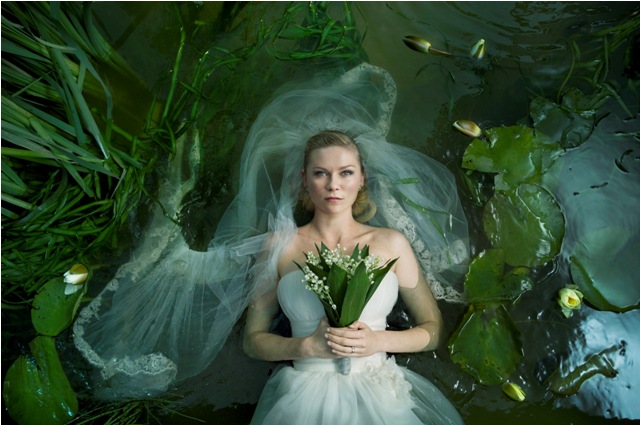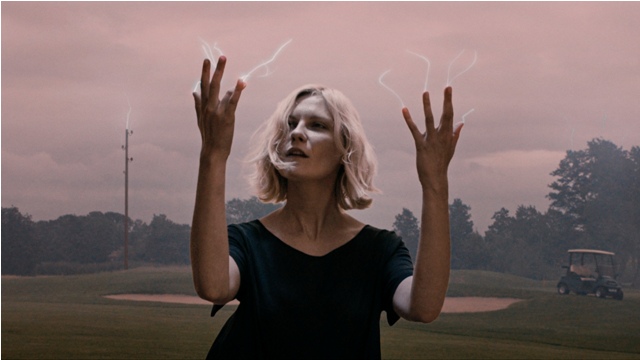CHICAGO – Patrick McDonald of HollywoodChicago.com appears on “The Morning Mess” with Dan Baker on WBGR-FM (Monroe, Wisconsin) on March 21st, 2024, reviewing the new streaming series “Manhunt” – based on the bestseller by James L. Swanson – currently streaming on Apple TV+.
Lars Von Trier’s Mesmerizing ‘Melancholia’ Turns Depression Into Art
 Rating: 5.0/5.0 |
CHICAGO – Lars Von Trier’s “Melancholia” is a mesmerizing, haunting portrayal of the world-shattering force of depression from a filmmaker who has first-hand knowledge of the debilitating disease. With career-best work by Kirsten Dunst and some of the most confident filmmaking from its controversial director, this is one of the best films of 2011, a stunningly original examination of that which is completely out of our control.
Split evenly into two halves, the first fifty percent of “Melancholia” takes place at the wedding of Justine (Dunst) and Michael (Alexander Skarsgard). What should be one of the happiest days of Justine’s life is presented not as a total disaster but as the story of someone increasingly aware that one is looming on the horizon. Through dialogue, we learn that Justine has dealt with the darkness of depression in the past and it seems like, even on this wonderful day, it is creeping back into her life, not unlike the planet Melancholia that some fear is on a collision course with Earth.

Melancholia
Photo credit: Magnolia
At the wedding, we also meet Justine’s sister Claire (Charlotte Gainsbourg), brother-in-law John (Kiefer Sutherland), father (John Hurt), and mother (Charlotte Rampling). Her family is supportive (in a Von Trier way) but also seems exhausted by their troubled relative. We also meet Claire’s boss Jack (Stellan Skarsgard) and his assistant (Brady Corbet) while great characters actors like Udo Kier and Jesper Christensen enhance the background. These wedding scenes are often comedic (especially with Hurt) and feature Von Trier at his most playful in years. Unlike some of his recent dirges (“Antichrist,” “Manderlay”), he actually seems to be having a good time telling the saga of Justine & Michael’s mostly-disastrous nuptials.
The second half of the film pares back on the characters and ups the dread as the planet Melancholia seems to be headed straight for our planet. Justine is certain that it will wipe out humanity. John is certain that it will not. Claire is mostly just uncertain. The metaphor for depression grows even stronger as the film approaches science fiction. Depression is not merely a minor setback – it destroys humanity. And for everyone who thinks that it will just miss them, there’s someone who knows it will forever change them.
“Antichrist” was a deeply flawed film with some strong visuals even if they weren’t adequately assembled into a coherent feature. Von Trier’s sense of merging the mystical with the natural world is much stronger here and the result features some of his most memorable cinematic compositions to date. The film opens with a series of barely-moving paintings depicting the end of the world and they serve not merely as artistic excess but as thematic overture. They get under your skin and stay there, making the wedding feel more doomed and depressing. It is only one example of how accomplished Von Trier is here at using his more excessive tendencies in pursuit of relatable human emotion.

Melancholia
Photo credit: Magnolia
“Melancholia” is nearly a greatest hits for the auteur in how successfully it combines his various styles. He’s long been a filmmaker who vacillates between over-the-top imagery and raw human interaction. Sometimes that can lead to a bipolar final product, one that’s inconsistent in its tone. There’s absolutely nothing inconsistent about “Melancholia.” It features not one shot, idea, or performance that feels out of place or not of the overall piece.
Von Trier has long been accused of misogyny in his work as most of his films feature a tortured heroine (“Breaking the Waves,” “Dancer in the Dark,” “Dogville,” “Antichrist”) but in doing so he often draws great work from his lead performers. “Melancholia” doesn’t contain the standard filmmaker’s misogyny (although there are hints of it) but Von Trier still finds something within his lead star that was previously only hinted at. Dunst gives a deep, challenging performance. We can almost see this vibrant woman, laughing so heartily at the difficulty she has getting to her own reception, fading away as depression overtakes her. It’s a riveting performance. And she’s ably assisted by the always-great Gainsbourg and scene-stealing work from Hurt and Rampling in the first act.
Ultimately, Lars Von Trier has never been this focused. He’s always been a filmmaker who swung for the fences artistically but it seemed more and more in recent years like he wasn’t going to make contact again. This is a creative home run.
 | By BRIAN TALLERICO |


